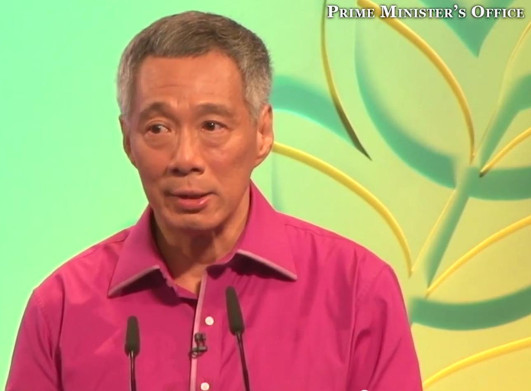PM's National Day Rally: A speech of contradictions?
(from Newzzit; the original story is here http://newzzit.com/stories/pms-national-day-rally-a-speech-of-contradictions)
Quick Summary
Housing: Is $20,000 “not so small” or “not much more”? PM used both phrases to describe the same amount, when he acted as the “housing agent” for all Singaporeans.
Health: MediShield Life to cover all Singaporeans regardless of pre-existing illnesses for life, but premiums will go up leaving existential questions of healthcare affordability unanswered.
Education: “Every school is a good school”, he repeated MOE's mantra, while adding “it is also good that we have top schools nationally”, leaving doubts whether the scramble for “top schools” will continue.


Is$20,000 “not so small” or “not much more”?
Whileannouncing the extension of the Step-up Housing Grants tomiddle-income households vying to buy a 4-room flat, the PM said, “Sowhat it means, net-net, is a middle-income household buying a 4-roomflat can get a saving of up to $20,000, which is not so small.$20,000 more than what they are getting today which is already not sosmall.”
Furtherin his speech, when acting as the “housing agent” for allSingaporeans, Lee gave the example of a 3-room flat at HDB'sFernvale Riverwalk BTO project in Sengkang. Informing the audiencethat the cheapest such flat costs $150,00, he added,” So a typicalFernvale 3-room flat BTO price is a bit more than $150,000 but notmuch more; it is $170,000.”
Thisleft many wondering how$20,000 is “notso small” when government gives a grant and the same amount becomes“not much more” when people complain of rising home prices.
3Mframework revamped; premiums up; healthcare affordable?

TheGovernment Parliamentary Committee (GPC) for health ledby Dr Lam Pin Min, which submitted it's report to the Ministryof Health (MOH)few days prior to PM's speech took a “person-centric perspective”and suggested ways of improving healthcare affordability forSingaporeans. [Fora detailed story on this, please read our Majulah Singapura! Section]
TheGPC had noted that “the Consumer Price Index for healthcareservices in particular rose by about 5.5% in 2012. For manySingaporeans, healthcare costs have been perceived as spiralling outof control and it is becoming increasingly expensive to see a doctor,least to say, to fall ill”. To mitigate this, the committeesuggested “Medisave limits should be raised across the board andsubsequently pegged to medical inflation rates” and “thegovernment step in to guarantee the continuity of MediShield coveragefor those Singaporeans who cannot afford to pay”.
ThePM agreed with the GPC in parts and announced extending Medisavefunds to be used for outpatient treatments as well as relaunchingMediShield as MediShield Life providing universal coverage to allSingaporeans even for chronic illnesses.

But,as government subsidies are going up, individuals have to contributetoo by taking responsibility for their health. Thus, Medisave rateswould also have to go up over time and MediShield Life’s premiumswill have to be higher, Lee added.
Thiswhen the GPC had this to say about the existing MediShieldpremiums,“Feedback that the GPC has gathered showed that there is a portionof Singaporeans who have allowed their MediShield coverage to lapse.There are several reasons. The first of which is that MediShieldpremiums have risen so high during their old age, it has becomeimpossible for Singaporeans to maintain their coverage. Even periodictop-ups by the government to the Medisave meant as payment forMediShield premiums, were in vain as these were utilised for hospitalbill payments. The negligible Medisave accounts meant that the yearsof paying for MediShield have effectively been wiped out. Evenmedical professionals like doctors shared that they woulddeliberately advise elderly patients to allow their MediShieldcoverage to lapse as the premiums were too high.”
Ifthe existing premiums are unaffordable, how will the governmentsubsidise even higher premiums remains to be seen.
“Every school is a good school” but “it is also good that we have top schools nationally”

Tohis credit, the PM acknowledged problems associated with PrimarySchool Leaving Examination (PSLE) T-scores. “One point differencein the PSLE T-scores, 230 versus 231, may make all the difference inyour secondary school posting. But at the age of 12, one examination,four papers and you want to measure the child to so many decimalpoints and say well, this one got one point better than that child?It is a distinction which is meaningless and too fine to make,” hesaid. Why did it take so long for his government to realise this isanother matter?Itwas 1982 whenthe policy of issuing T-scores to the students was implemented.
Itis this fascination with T-scores that has led to preferentialtreatment of schools by parents in Singapore. This year's Primary 1(P1) registration exercise is a classic example. After the first twophases – for siblings of children studying in the same school andfor children whose parents are members of the school's alumniassociation – about two-thirds of the places were taken up inpopular schools such as St Nicholas Girls', Henry Park and NanyangPrimary. In contrast, lesser-known so called “heart-land” schoolshad more than 300 seats to be filled after these phases.

Thuseven though the PM, in his speech, reiterated the government'scommitment and progress made in ensuring every school is a goodschool by giving them resources and good teachers, the reality isthat parents prefer few schools more than the others. And these areinvariably the “top schools”.
Forthat, the PM said, “I think it is also good that we have topschools nationally, schools which are acknowledged as outstanding, solong as we keep our system open.” This openness will be achievedfrom next year, when every primary school will be setting aside 40places, at least, for children who have no prior connection with theschool in P1, he added.
Now,as acknowledged by the PM himself, the key education milestones of achild – P1 or PSLE – are high stress moments for the entirefamily as it is a scramble to get into the “top schools”. Howwill his government reconciles the ministry of education perspectiveof “Every school is a good school” while at the same timemaintaining a hierarchy of schools is anybody's guess.
